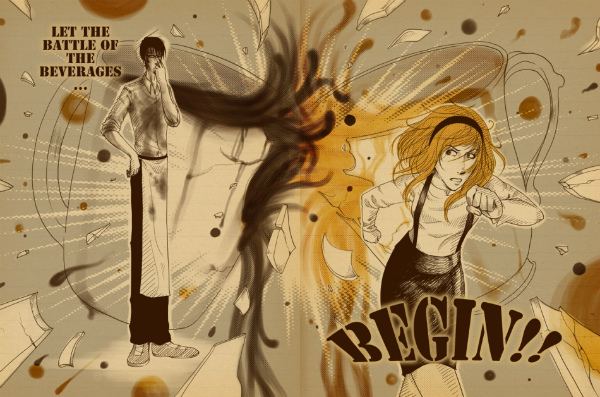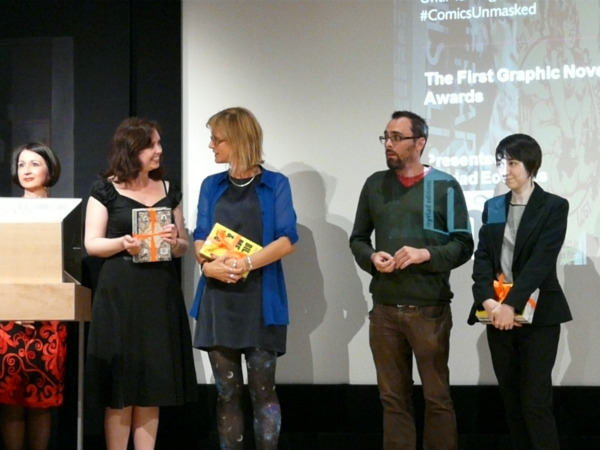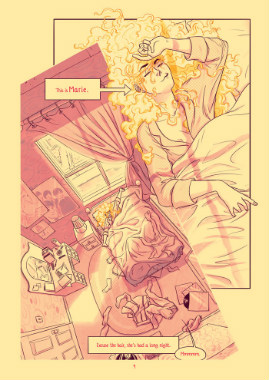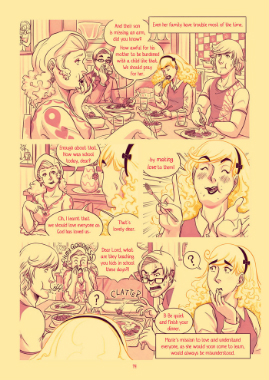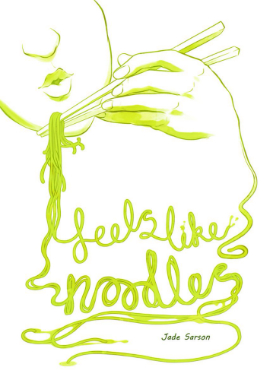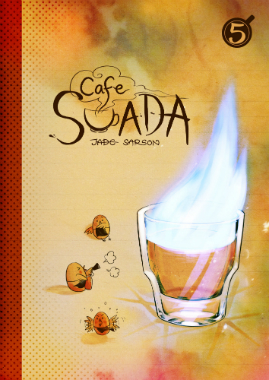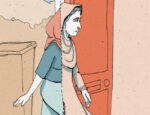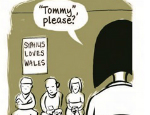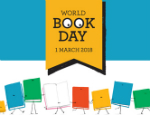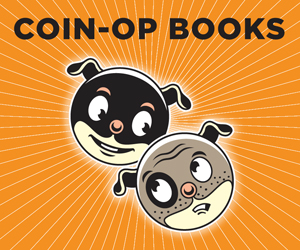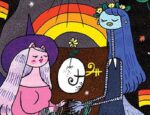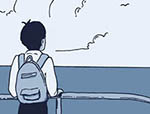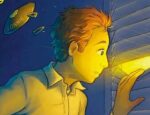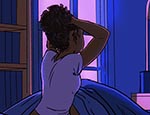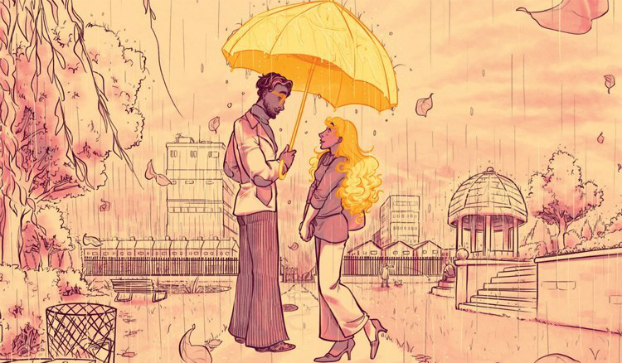
MYRIAD WEEK!
Way back in 2012 in my ‘Small Pressganged’ column at Broken Frontier I first alerted our readership to a promising new talent I had come across in the pages of the londonprintstudio’s Parallel Lives anthology; a book that showcased the work of their comics internship programme that year. That artist was Jade Sarson and I would go on to champion her work in self-published offerings like Cafe Suada. In 2014 I was part of the Myriad First Graphic Novel Competition judging panel that chose For the Love of God, Marie! – her graphic-novel-in-progress – as that year’s winner.
We like to pride ourselves on being the first site to bring tomorrow’s stars to a wider audience here at BF and Jade’s remarkably confident and universally acclaimed debut graphic novel For the Love of God, Marie! is proof positive of her undeniable status as one of the breakout stars of UK comics in recent years. Indeed, she was also nominated for two Broken Frontier Awards for 2016.
Today, as part of our Myriad Week at BF, I catch up with Jade and chat about how the years have treated her since Parallel Lives, what winning the Myriad First Graphic Novel Competition meant to her, and creating the endearing free spirit Marie…
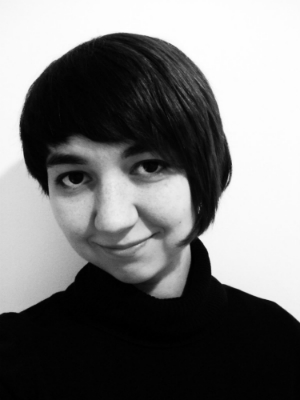 ANDY OLIVER: It’s been five years now since I first covered your work at Broken Frontier and marked it out as the highlight of the londonprintstudio anthology Parallel Lives. What have been some of the highlights of the intervening years for you?
ANDY OLIVER: It’s been five years now since I first covered your work at Broken Frontier and marked it out as the highlight of the londonprintstudio anthology Parallel Lives. What have been some of the highlights of the intervening years for you?
JADE SARSON: It feels like forever ago I was working on that anthology with the LPS gang. Haha! Things have certainly snowballed since. Hmm, I certainly think getting opportunities to meet talented people and work with them on unique projects have stood out the most. Like psychologist Nina Burrowes and The Courage to Be Me, or Webcomic Artist Swap Project Week, or LICAF and my 24-hour comic Feels like Noodles! Collaboration is always really fulfilling, but I also had enough control on these projects that I was satisfied with the art I created with them.
Your style is very rooted in manga. What and who do you count among your inspirations and influences?
Oh NUMEROUS sources, goodness, too many to name. I’ll just mention those that stand out in my mind right now (and if you want more, I probably mentioned other names in my old BF interview 4 years ago!). Fumi Yoshinaga is still a strong influence, with her negative space and delicate art – but lately I’ve been really inspired by her current series What Did You Eat Yesterday?
I’m also nearly done collecting Monster by Naoki Urasawa, which is an incredible work full of great dramatic, tense comicking and such variety of character design. In recent years I’ve also become obsessed with Akiko Higashimura and her wild, over-the-top but so REAL, hilarious female characters, especially in Princess Jellyfish.
Since we last spoke I’ve also been getting into more Western creators, too like Yuko Ota, Jess Fink, Erika Moen, Jen Wang, Leslie Hung and Heather Campbell (particularly her work on the Team Fortress 2 comics, which are fantastic.). Revelling in these creators’ gorgeous works as well as manga has helped me to loosen up I feel, and be more focused on expressive storytelling and interesting characters rather than the technicalities like perfect perspective or idealised anatomy.
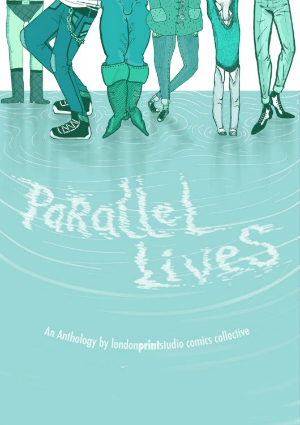
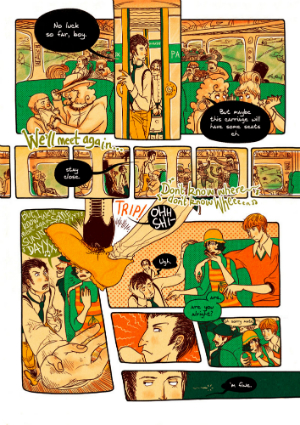
The Parallel Lives anthology (left) and Jade’s story therein Siddown! (right)
The first of your longer-form work that we covered here at BF was your webcomic Cafe Suada (below) which is still going strong. Tell us about the colourful cast of characters within its pages…
It’s come quite a way since then huh? We’re on Cup 6 (Chapter 6) now! The main character is Geraldine, a brash but hard-working tea specialist whose teahouse, unfortunately, finds itself next door to a coffeehouse and bar run by flamboyant barista Ewan. Both establishments are owned by Cream, an eccentric woman into a variety of over-the-top fashions who likes to meddle and cause drama.
They are joined later by an extended cast of young waiting staff with their own naïve problems and silly love stories, a writer enamored with Geraldine and a bookshop owner jealous of that fact, and more. The overarching narrative is one of silly rivalry, blossoming romance and egocentric obsessions.
In 2014 you won the Myriad First Graphic Novel Competition for For the Love of God, Marie!. As someone best placed to speak about its impact with authority what would you say is the importance of that competition to aspiring creators? And how did it feel to win it yourself in 2014?
Winning it had a massive impact on me, and was a huge surprise, as I’m sure most who attended the award ceremony remember! (I was really shocked, sat in my seat for quite a while thinking you’d made a mistake!) I’d been entering competitions for a while, and submitting work to publishers, but nothing had been gaining traction until I won the competition. Because of the esteem the industry has for the judges, and that the judges have for all the shortlisted entrants, the competition awards a respect and an acknowledgement that YES, you can make excellent comics, and people should really give your work a look. Even without winning, the other nominees have gone on to great success, getting their books picked up by other publishers who saw the opportunities to support great work.
As one of the judges of that competition I can say now that your obvious understanding of the particular narrative language of comics was apparent to us all in the evaluation process. What are the unique storytelling opportunities of the form for you?
It’s always so nice to hear you speak of the language of comics. Not everyone understands that that’s a thing! It’s not just stories with illustrations, or pictures with words – comics have their own unique flow and tropes and iconography and timing, it’s really the only medium for me. Better even than cinema. For me, it’s all about the timing – illustrating a story in a way that forces the reader to feverishly flick through pages of panels of action and drama to reach the conclusion, then stop and revel in that exciting, possibly shocking or unexpected conclusion for a long time and admire the scene they are presented with? That is the most satisfying thing in the world to me.
Jade (far right) at the Myriad First Graphic Novel Competition in May 2014
It’s my favourite thing to read in other comics work too! However, what makes comics truly unique with regard to this timing aspect is every reader will have a different experience – if you are watching a film, you have to experience the timing exactly as the director intends. Even if your shock dictates you need more time to process what you’re presented with, a film will move you on to the next bit, whereas comics offer you that realistic feeling of timelessness.
You could have spent five minutes or a day reading a comic, but to you the story happened in exactly the right amount of time in your mind. Yes, you get this with prose too, but comics have visual cues to help your imagination flesh out the scene more. And yes, you can pause a film if you really want to, but that ruins your immersion. I’ve rambled enough at this point, but I hope you get what I mean. There’s just too unique a sense of time in comics for me to want to create anything else.
When we last spoke in that interview here at BF a few years back you told me that you had an idea for a project that was “something a little sexier… probably for older readers”. I don’t know if it was For the Love of God, Marie! that you had in mind then but it sounds like it could well have been! For those yet to pick it up what’s the basic premise of the book?
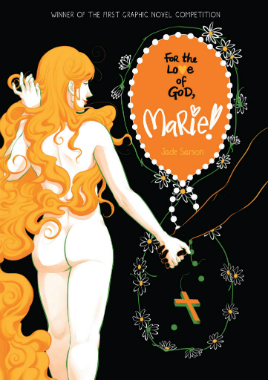 It totally was Marie! I had no idea it would go on to such success when I mentioned it at the time. The story is about a young British woman raised as a Catholic during the ’60s. She awakens to her bi/pansexual identity at arguably the best and worst time – a time of so-called free love, but also one of restrictive lives for women and minorities, legally speaking. Naively, Marie sets out to love and heal many people with sexual relationships, not realising she has a lot to learn about them and herself before she can do that. The book covers her relationships up until the mid ’90s.
It totally was Marie! I had no idea it would go on to such success when I mentioned it at the time. The story is about a young British woman raised as a Catholic during the ’60s. She awakens to her bi/pansexual identity at arguably the best and worst time – a time of so-called free love, but also one of restrictive lives for women and minorities, legally speaking. Naively, Marie sets out to love and heal many people with sexual relationships, not realising she has a lot to learn about them and herself before she can do that. The book covers her relationships up until the mid ’90s.
For the Love of God, Marie! tackles themes of sexism, identity, gender, religion, and racism with great empathy and potency. Can you elaborate on the book’s message and the ways in which comics as a form is such a powerful medium for communicating it?
These are all delicate subjects, often explored in harmful or negative ways in popular media. I wanted to explore the effect these issues have on characters in both an introspective and lighthearted manner, so that readers could contemplate their own opinions on the events but have a good laugh at the same time. Comics afford a unique opportunity to jump quickly between serious and humorous visuals without taking the reader out of the story, so I was able to strike the balance I wanted.
I like to think the book doesn’t have a set message, despite me having firm opinions on a lot of the issues, I want Marie’s story to convey that there is no right answer to issues like the meaning of life, love or sex. Essentially I hope it just helps people to be good to each other, and maybe a little more open-minded!
How different an experience was it to be working with an editor (Corinne Pearlman) at Myriad in comparison to self-publishing. In what ways did the book evolve with that additional input and discussion?
I think it became much more accessible and had stronger clarity because of Corinne’s input. Sometimes I have trouble knowing if I am articulating my points clearly enough, so Corinne was a really important filter to make the script and overall themes understandable. She also helped rein me in when I got too surreal or unrelatable in my characterisations. We butted heads a bit over hyper deform art styles, haha, but that’s good! It was important to know how different people would read the visuals, so we ended up with a beautiful and easy to interpret book, without being too preachy or simple.
Your use of colour is such an evocative part of your work. Can you tell us a little about how you use it to emphasise a sense of space, time and theme in comics like Cafe Suada and For the Love of God, Marie!?
The yellowed paper was an important choice for Marie that was inspired by the browned paper of Cafe Suada. I chose it to mimic the effect of paper aging over time, as if the pages themselves are as old as the scenes they depict, getting lighter and lighter as we reach the modern era. I also chose not to use panel edges for every panel, which was an unusual move for me, but an important one for the book – the scenes felt much more like memories of Marie’s this way, and any time I did use panels helped to emphasise important moments. For Café Suada, the brown paper was more to emphasise the tea theme and evoke a warmth in the reader. As if the world was a comforting, cosy place they can return to whenever they want, just like a cuppa tea.
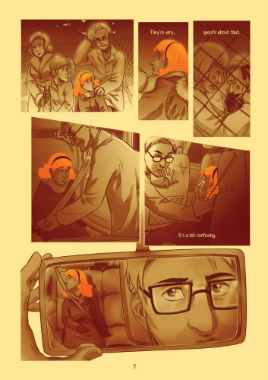 Given the jumping timeframes of Marie how did you go about researching the book?
Given the jumping timeframes of Marie how did you go about researching the book?
It was probably the most frustrating part of making the book. I made so many test pages trying to evoke the eras I was illustrating. What I had to do was study, basically! I had to learn as much as I could about the limitations of fashion, graphic design, law, and actual historic events so that those limitations could help narrow down what to draw in the different eras. What made it difficult was having not lived in the ’60s-’80s. I remember the ’90s, I can think of what commonly existed on a street, in a house, in a wardrobe. But I can’t picture those things for myself for the other eras, so studying up was the only way to do it! I’ve still got folders full of art and photos that were necessary for putting my mind in the right settings.
Did you have a particular target audience for Marie? Was there a specific demographic you were looking to pitch the book at?
I never really have a specific audience in mind when I create comics, I just hope that those who will like the story will find it. But… that’s not a good marketing strategy, so if I had to say it’s split in to two groups: 1) People with strong feelings about sexuality and love, who can empathise with Marie and find comfort in her support, or 2) People who might be a bit narrow minded about the issues confronted by the book, who may consider thinking a bit more about how their attitudes and presumption to know exactly the right way to live can hurt others.
As a critically acclaimed creator who has so successfully risen from the ranks of the small press scene what advice would you have for new artists now entering the self-publishing world?
Can I yell? I’m going to yell. BE CONFIDENT AND SHOW PEERS/MENTORS YOUR WORK. I’ve met too many young artists now who keep insisting their work isn’t good enough, but want me to look at it anyway. Why should I? If you don’t want anyone to see it, no one will look. So if you truly want people to see it, tell us. Be confident in yourself (of course, be humble as well, no one likes a show-off. Just be realistic about what you’ve achieved and enthusiastic about letting people know about it. Okay? You gotta toe the line!)
Also, take every advantage. Try different avenues to everyone else. There is no right way into the industry, everyone knows that. So research! Find out what sources of funding are out there, what opportunities could be used to help you. A lot of comics I’ve made have been for projects that didn’t specifically ask for comics. I just barged in where I saw the opportunity to and said HEY. YOU. LET ME MAKE A COMIC FOR YOU. ALSO PAY ME. Because I was confident and had a strong portfolio/work ethic and tailored my pitching to their requirements, it often worked!
And, finally, what’s next for Jade Sarson? Are there any new projects you’re working on that you can tell us about?
I’m really looking forward to a small break to just focus on Café Suada once my recent freelance work is finished. I’ve been working on multiple short comics and multimedia projects since finishing Marie, but I haven’t really had a break, it’s been one after another! (Which is exciting, certainly, and fun, plus financial security, woo.) So I want to focus on Geraldine’s story for a bit and develop the comic’s Patreon campaign so that I can offer more interesting things for readers.
I am, however, also eyeing up another opportunity, with another story. Maybe this’ll work in my favour, like when I teased Marie and then it got published? Ohoho, let’s come back in another 4 years and see. I can tell you this: the protagonist is older than Geraldine and Marie. And she’s very… sporty.
For more on Jade Sarson’s work check out her site here. Cafe Suada can be read for free online here. You can buy print copies from her shop online here. Follow Jade on Twitter here.
You can buy For the Love of God, Marie! online here.





